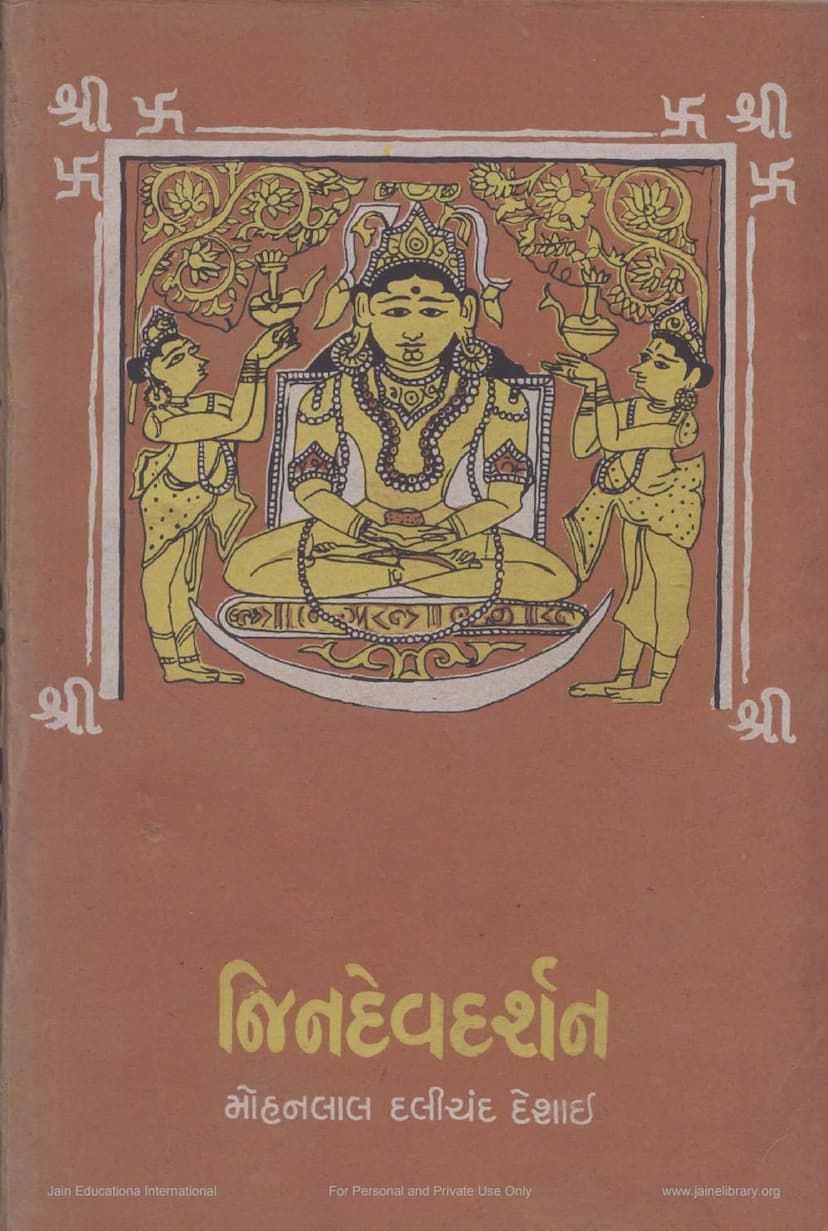Jindev Darshan
Added to library: September 2, 2025

Summary
Here is a comprehensive summary of the Jain text "Jindev Darshan" by Mohanlal Dalichand Desai:
Book Title: Jindev Darshan (જિનદેવદર્શન) Author: Mohanlal Dalichand Desai Publisher: Mahavir Jain Vidyalay Subject: Jain ritual and practices related to idol worship and veneration of Jina.
Overview: "Jindev Darshan" is a significant work by Mohanlal Dalichand Desai, first published in 1910, that elucidates the Jain rituals and practices associated with the veneration of Jinas (Tirthankaras). The book aims to provide a clear understanding of the purpose, methodology, and significance of devotion to the Jinas, making it a crucial guide for the Jain community. This edition is the third printing, revised and published by Mahavir Jain Vidyalay in 1989 as part of the Shri Mohanlal Dalichand Desai Smarannidhi Granthamala.
Key Themes and Content:
-
The Importance of Jina Darshan (Vision of the Jina):
- The book emphasizes that seeing the Jinas (through idols or representations) is a fundamental religious practice that leads to the destruction of negative karma and the attainment of spiritual well-being.
- It highlights that Jina Darshan is not merely an outward act but an essential step towards understanding the path to liberation (moksha).
-
The Nature of the Jina Idol and Devotion:
- The text describes the divine form of the Jina, emphasizing its serene and detached nature, reflecting the absence of attachment and aversion (raag and dvesh).
- It clarifies that the idol is a representation, and devotion to it is a means to connect with the inherent qualities of the Jina, such as omniscience, infinite vision, infinite conduct, and infinite energy.
-
The Six Essential Jain Practices (Awashyak Kriya):
- The book briefly outlines the six essential daily practices in Jainism: Samayika, Chaturvinsati Stava (Jina Darshan/Vandan), Vandan, Pratikraman, Kayotsarga, and Pratyakhyana.
- It focuses specifically on Chaturvinsati Stava (Jina Darshan/Vandan), which constitutes the core subject matter of the book.
-
Purpose of Jina Devotion:
- Devotion to the Jina is presented as a way to internalize their virtues and strive for liberation.
- It serves as a means to purify the mind, overcome karmic obstacles, and cultivate spiritual awareness.
- The book stresses that devotion, when performed with the right understanding and intention, leads to the attainment of both worldly prosperity and ultimate salvation.
-
Types of Worship:
- Dravya Puja (Material Worship): The book details various forms of material worship, including Anga Puja (worship of the idol's body) and Agra Puja (worship with offerings placed before the idol). It describes the eight principal offerings (Ashtaprakari Puja) such as water, sandalwood, flowers, incense, lamp, rice, fruits, and sweets, emphasizing the inner devotional aspect associated with each.
- Bhava Puja (Internal Worship): This is considered the higher form of worship, involving the contemplation of the Jina's virtues, the purification of one's own mind, and the aspiration to embody those virtues. It includes practices like remembering the Jina's teachings, meditating on their qualities, and cultivating equanimity.
-
Rituals and Procedures:
- The book meticulously outlines the step-by-step procedures for Jina Darshan and worship, including:
- Angashuddhi: Maintaining bodily and mental purity before entering the temple.
- Dasha-trik, Abhigam, Dwidisha, Avagraha, Vandana, Pranipata, Namaskara: Detailed descriptions of the correct postures, movements, and respectful greetings to be observed within the temple premises.
- The Significance of Sacred Symbols: Explanations of symbols like the Swastika (indicating the four states of existence and the path to liberation).
- Mantra Chanting: The importance and correct pronunciation of sacred mantras like the Navkar Mantra and "Jay Veeray".
- The Purpose of Chaitryavandan: Explaining various types of Chaitryavandan (veneration of the temple) – Jaghanya (elementary), Madhyama (intermediate), and Utkrushta (highest) – and the specific sutras associated with each.
- Eight Greatnesses (Pratiharya) and Four Perfections (Atishaya): Detailed descriptions and the spiritual significance of the divine attributes and marks associated with Tirthankaras.
- The book meticulously outlines the step-by-step procedures for Jina Darshan and worship, including:
-
Aashatana (Offenses in Worship):
- A significant portion of the book is dedicated to outlining various offenses (Aashatana) that can occur during temple visits and worship. These are categorized into gross (10), intermediate (42), and subtle (84) offenses, covering aspects like improper conduct, impure thoughts, misuse of temple property, and disrespect towards the sacred. The book strongly advises against these actions to ensure the efficacy of devotion.
-
The Current Environment and Call for Purity:
- The author laments the current state of affairs in some Jain temples, where excessive noise and lack of decorum disrupt the devotional atmosphere.
- He calls for a return to the pure and serene environment that should characterize a place of worship, emphasizing the need for peace, concentration, and respectful behavior.
-
The Role of Knowledge (Gyan) and Inner Purity:
- The book stresses that true devotion requires not only outward rituals but also inner purity of mind and a certain level of knowledge about the Jinas, their teachings, and the meaning behind the rituals.
- It encourages readers to cultivate intellectual understanding and spiritual maturity for a more profound devotional experience.
-
Author's Intent and Legacy:
- Mohanlal Dalichand Desai's primary intention was to revive and disseminate accurate Jain practices, addressing potential misunderstandings or deviations from tradition.
- The republication of this work by Mahavir Jain Vidyalay, supported by a generous donation in memory of the author, signifies its enduring value and relevance for contemporary Jainism.
In essence, "Jindev Darshan" serves as a comprehensive manual for Jains on how to approach, venerate, and worship the Jinas with the correct understanding of the rituals, their spiritual purpose, and the necessary inner disposition. It aims to foster a deeper, more meaningful connection with the Tirthankaras and guide the practitioner towards spiritual progress and eventual liberation.